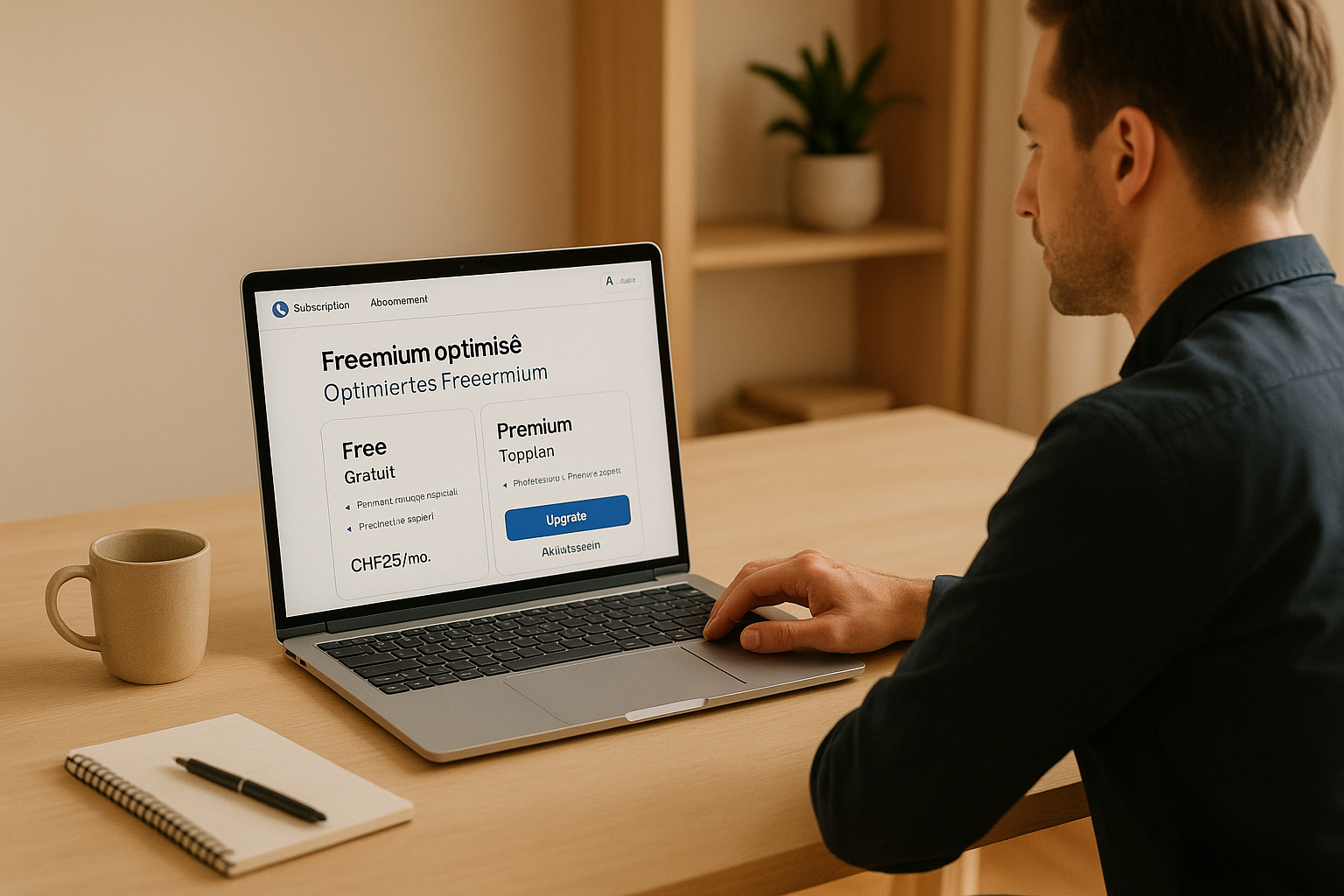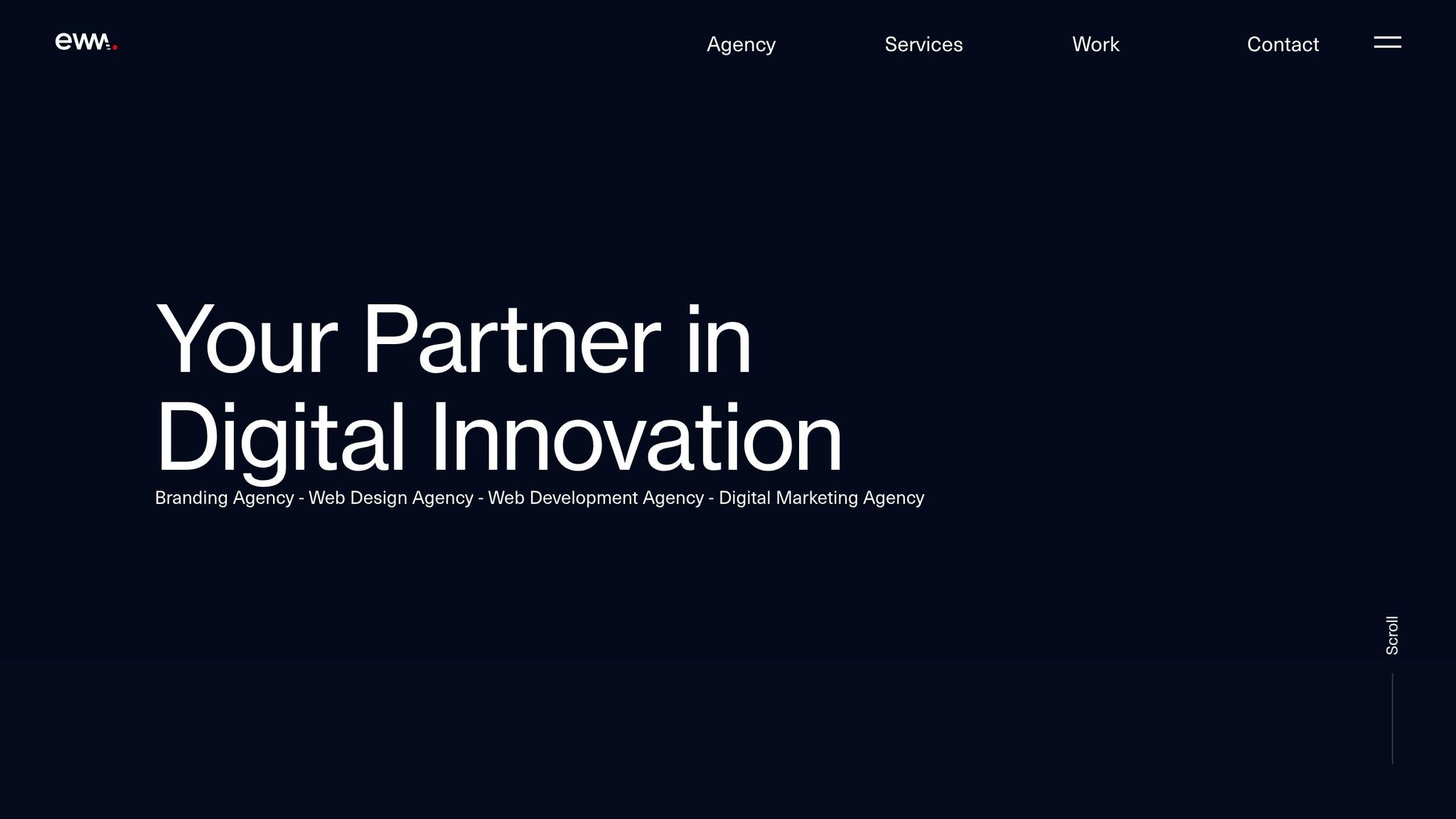
Freemium optimized: convert free users into paying customers
Optimized Freemium: Converting Free Users into Paying Customers
The freemium model, which combines a free offer with paid options, is a strategy favored by Swiss companies, especially in the .
Here are the key points to maximize conversions from free users to paying customers:
- Conversion Rate: Target between 2% and 5% by optimizing the offered features and incentives to upgrade to a premium version.
- Personalization: Use behavioral data to offer tailored offers through notifications or targeted campaigns.
- Bilingual User Experience: In Switzerland, offering interfaces in multiple languages (French, German, Italian) is essential to reach a diverse audience.
- Clear Pricing: Offer monthly, annual, or usage-based subscriptions while respecting local standards (CHF, date format, etc.).
- Key Moments for Upgrades: Identify moments when users reach the limits of the free version or show strong engagement.
Success Example: A Geneva-based startup increased its conversions through personalized journeys and tailored offers, while respecting local expectations for transparency and quality.
With these approaches, Swiss companies can turn their free users into paying customers while strengthening their position in a demanding market.
Creating Bilingual User Experiences
Designing Bilingual User Journeys
Creating effective bilingual journeys requires overcoming both technical and cultural challenges. The goal? Ensuring a consistent experience in both languages, without loss of context or interruption, while allowing for smooth switching between them.
To achieve this, integrate a prominently visible language switch button, ideally in the header. Use internationalization tools like React Intl or Lokalise to manage dynamic translations, whether for notifications, pop-ups, or error messages.
Record the language preference in the user session or account. This prevents visitors from having to choose their language on each visit. User tests often show that small details like this can reduce friction.
A study conducted by CSA Research in 2023 indicates that 76% of consumers prefer to buy products with information in their language, while 40% outright refuse to buy if that's not the case [1]. In Switzerland, where over 60% of the population speaks multiple languages, offering bilingual interfaces can become a major asset.
These practices are essential for successful localization, particularly in a multilingual market like Switzerland.
Localization for the Swiss Market
Localizing a product goes beyond translating content. It involves adapting all elements to Swiss local standards, whether linguistic, cultural, or technical. Here are some essential points:
- Currency: Use the CHF format (e.g., 49.90 CHF).
- Dates: Respect the Swiss format dd.mm.yyyy (like 22.08.2025).
- Numbers: Apply apostrophe as a thousand separator and period for decimals (example: 1'234.56).
- Measurement Units: Adopt the universally metric system: kilometers for distances, kilograms for weights, and degrees Celsius for temperatures.
These conventions must be consistently applied in both languages. For example, a pricing page should display "CHF 49.90" in both French and English, and dates should always follow the Swiss format, even for events or billing cycles.
| Element | Swiss Standard (fr-CH/en) | French Standard (fr-FR) |
|---|---|---|
| Currency | CHF (e.g., 49.90 CHF) | EUR (e.g., 49.90 €) |
| Date Format | dd.mm.yyyy (22.08.2025) | dd/mm/yyyy |
| Numeric Format | 1'000.00 (apostrophe/period) | 1 000,00 (space/comma) |
| Measurement Units | Metric Only | Metric Only |
| Language Switch | Always Visible, Main Navigation | Often in Footer |
Best UI/UX Practices for Multiple Languages
After adjusting the content to local standards, it is essential to ensure that the user interface remains intuitive and pleasant, regardless of the chosen language.
Clear navigation is essential. Menus, action buttons, and other interactive elements should be translated and tested in both languages. Prefer a simple and direct language for calls to action, taking into account Swiss expectations, which favor precision, discretion, and neutrality. Avoid puns or humor that is difficult to translate, and ensure that privacy policies are accessible in both languages.
Visual elements such as icons, colors, or highlights should remain neutral and understandable for both French-speaking and English-speaking users. A/B testing can help identify linguistic preferences and adjust journeys accordingly. For example, a Locize survey from 2024 reveals that bilingual or multilingual SaaS products in Switzerland record up to 18% additional conversions compared to monolingual solutions.
While automatic language detection via the browser or device simplifies the initial interaction, it is essential to allow users to manually change the language. Also, consider regional specificities: for example, Swiss French uses "septante" instead of "soixante-dix." These details enhance the authenticity of localized interfaces.
Finally, it is crucial to ensure equality of features between language versions. Users should never feel that one language is favored, whether in design or access to advanced options. Such an approach promotes engagement and can encourage users to opt for premium versions.
Converting Free Users into Paying Customers
Using Data for Personalization
Personalization plays a key role in turning free users into paying customers. The goal? Identifying opportune moments and sending tailored messages to encourage an upgrade.
Tools like Google Analytics 4 and Mixpanel allow tracking essential indicators: time spent on certain features, usage frequency, or friction points. For example, if a user regularly views advanced reports but encounters limitations in the free version, they become an excellent candidate for a personalized offer.
To go further, platforms like HubSpot or Mailchimp facilitate user segmentation based on their engagement. This enables triggering targeted and relevant campaigns.
But personalization doesn't stop at emails. Think about in-app notifications, contextual pop-ups, or premium feature recommendations tailored to specific needs. A web developer, for example, will be attracted to advanced technical tools, while an entrepreneur will prioritize reporting and analysis options.
Lastly, tailor your messages to local specificities. Behavioral data and user needs can also guide consistent and relevant pricing.
Pricing Tiers for SMEs
To attract Swiss SMEs, a flexible pricing grid is essential. These companies often seek options that adapt to their growth and needs.
| Subscription Type | Advantages | Disadvantages | Ideal for |
|---|---|---|---|
| Monthly (e.g., 49.90 CHF/month) | Great flexibility, limited commitment | Higher overall cost, frequent billing | Startups, short projects |
| Annual (e.g., 499.00 CHF/year) | 15-20% savings, better cost control | Long-term commitment, higher initial payment | Established SMEs, stable budgets |
| Pay-as-you-go (e.g., 0.50 CHF/action) | Payment based on actual usage | Unpredictable costs, complex tracking | Occasional users, testing |
A three-tier approach often works well: free, professional, and enterprise. The professional level, priced between 29.90 CHF and 99.90 CHF per month, suits SMEs with intermediate needs. The enterprise level, usually on quotation, targets large organizations with specific expectations.
In Switzerland, pricing transparency is particularly important. Avoid hidden fees and offer tools like online cost calculators. Providing the option to pay in Swiss francs and receive invoices compliant with local standards can also make a difference. Clear and well-thought-out pricing then facilitates the conversion to paid offers.
When and How to Offer Upgrades
The timing of offering an upgrade can make all the difference. If done too early, you risk frustrating your users. Wait too long, and they might turn to a competitor.
Friction points are often ideal opportunities. For example, when a user reaches a limit in the free version, such as the number of exports or allowed projects, they already understand the value of your service. This is the perfect moment to present them with an offer.
Periods of intensive use are also strategic. If a user logs in daily for a week, it reflects strong engagement. A discreet notification offering to test the premium version can then be effective.
To encourage conversion, offer attractive yet measured deals. A 20% discount on the first month or two months free on an annual subscription may be enough to convince. Offering a 14 to 30-day premium trial also demonstrates the value of your advanced features without immediate commitment.
In Switzerland, subtlety and added value are key. Avoid overly aggressive pop-ups or repetitive follow-ups. Prefer contextual messages that highlight concrete benefits, such as time savings, improved productivity, or access to tools specific to the user's activity.
Companies like EWM SA successfully apply these principles, guiding users towards a natural conversion while respecting local expectations for rigor and transparency.
Case Studies: Examples of Swiss Companies
Success Stories of Geneva SMEs
In Geneva, several SMEs have developed ingenious strategies to maximize the benefits of freemium models. These approaches demonstrate how to turn free users into paying customers through well-thought-out tactics.
Take the example of a startup specializing in project management. They implemented targeted notifications to encourage users to upgrade to a paid version. By segmenting their user base based on engagement level, they offered personalized suggestions to active users while providing specific advice to less engaged ones. The result? A significant increase in conversion rates in just a few months.
Another success comes from a fintech company. By focusing on total pricing transparency and personalized support, they organized individual 30-minute demonstrations for users who tested certain premium features. These sessions created direct connections with prospects, resulting in impressive conversions.
Lastly, in the online education field, a Geneva-based platform adopted a progressive approach. They first offer basic free courses, then unlock advanced content gradually. Users who complete multiple free modules receive a personalized offer with a discount on the annual subscription. This method, respecting the learning pace, promotes a natural transition to the paid offer.
These examples illustrate the strategies that EWM SA refines and adapts for its clients, based on similar approaches.
Freemium Solutions from EWM SA

Since 2011, EWM SA, based in Geneva, has been helping its clients develop freemium strategies tailored to the Swiss market while meeting international ambitions. The agency stands out for its bilingual solutions and local expertise.
Its approach is based on three main axes:
- Bilingual User Experiences: interfaces that automatically adjust to language preferences, optimizing conversions in French-speaking and English-speaking markets.
- Conversion Path Optimization: detailed behavioral analyses using Google Analytics 4 and heat mapping tools to identify and resolve user journey obstacles.
- Advanced Personalization: contextual pop-ups and recommendations based on user behavior.
For example, a client of EWM SA in the digital services sector saw a significant increase in conversion rates after redesigning their user journey and integrating personalized notifications. Additionally, the development of a bilingual platform attracted a European clientele, boosting initial revenues.
Performance Tracking for Better Results
Precise performance tracking is essential to adjust freemium strategies and achieve lasting results. Many Swiss companies use comprehensive dashboards to monitor their indicators in real-time.
Here are some key metrics to monitor:
| Metric | Tracking Frequency | Recommended Tool |
|---|---|---|
| Overall Conversion Rate | Weekly | Google Analytics 4 |
| Average Time to Conversion | Monthly | Mixpanel |
| Customer Lifetime Value (LTV) by Segment | Quarterly | Custom Dashboard |
| Churn Rate | Monthly | Stripe Dashboard |
Cohort analysis is also valuable. By grouping users based on their registration date, companies can identify conversion opportunities and retention factors. A Zurich-based startup discovered that the registration day strongly influences conversion rates, allowing them to adjust their communication strategy.
Completing these analyses with user feedback tools helps better understand real customer needs. For example, behavioral segmentation helps identify users most likely to convert, enabling personalized messages and optimized marketing efforts for maximum impact.
Pricing experts share top tips to turn freemium users into PAYING CUSTOMERS
sbb-itb-454261f
Conclusion: Turning Free Users into Paying Customers
The success of a freemium model in Switzerland relies on three key elements: a bilingual user experience, data-driven personalization, and conversion path optimization. These approaches, tailored to the specificities of the Swiss market, play a central role in converting free users into paying customers.
An interface that speaks to both French and German speakers, personalized recommendations through data analysis, and a UX/UI design aimed at simplifying the purchasing journey are levers to turn initial interest into financial engagement.
For over a decade, EWM SA